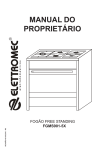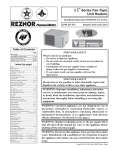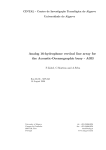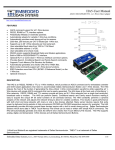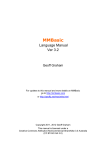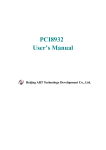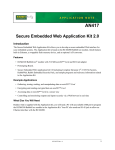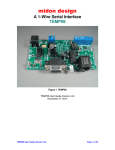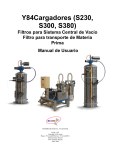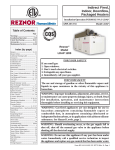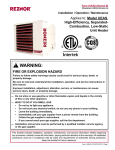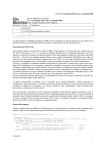Download AN420 - Simple Sensor Application Kit
Transcript
AN420 Simple Sensor Application Kit Introduction The Simple Sensor Application Kit provides a design reference for designers to implement the Dallas 1-Wire® bus technology in a Rabbit-based system. These Getting Started instructions and sample applications based on four 1-Wire® devices will help users to better understand and implement this communications bus system using a Prototyping Board and a RabbitCore module. Features • RCM4300 RabbitCore module with Prototyping Board • Includes DS2406 SPST addressable switch, DS18B20 temperature sensor, DS2450 A/D converter, and DS2480B line driver • Complete Dynamic C software CD with sample programs and reference information related to the Application Kit Example Applications • Low-cost embedded control applications using 1-Wire bus • Remote monitoring of equipment, devices, locations • Simple data-logging applications What Else You Will Need Besides what is supplied with the Application Kit, you will need a PC with an available USB port to program the RCM4300. Your PC also needs an RJ-45 jack to allow an Ethernet interface with the RCM4300. 022-0141 Rev. B 1 Interface Options The Simple Sensor Application Kit provides for four different methods to interface the 1-Wire bus. 1. Direct interface — this interface connects three 1-Wire devices on the 1-Wire bus directly to the Rabbit microprocessor serial port. The interface uses one serial port at 3.3 V CMOS levels to drive the 1-Wire bus. (The default configuration is Serial Port C PC3.) The 1-Wire devices have to be located close to the Rabbit microprocessor. 2. Discrete interface — this interface connects the 1-Wire bus to a high-current discrete driver circuit via transistors Q1 and Q2 that is controlled by the Rabbit microprocessor serial port. The discrete interface uses two serial port lines at CMOS levels to interface the transistor driver to the 1-Wire bus. (The default configuration is Serial Port C PC2 and PC3.) Several 1-Wire devices may be located considerably farther away from the Rabbit microprocessor than in the previous option. 3. Bit-bang direct interface — this interface connects the 1-Wire bus directly to a Rabbit microprocessor I/O port. The bit-bang interface for a RabbitCore module uses one parallel port line with an open-drain output — the default configuration is Parallel Port C bit 3, PC3. The bit-bang interface for a Rabbit singleboard computer uses two parallel port lines at CMOS levels. The transmit line is buffered to an opencollector/drain transistor output — the default configuration is Parallel Port A bit 1 (PA1) for transmit and Parallel Port B bit 0 (PB0) for receive. 4. DS2480 line driver interface — the DS2480 line driver interface connects the 1-Wire bus to an integrated component driver that is controlled by the Rabbit microprocessor serial port. The line driver interface uses two serial port lines at CMOS levels to control the transistor drive to the 1-Wire bus. (The default configuration is Serial Port C PC2 and PC3.) 022-0141 Rev. B 2 Hardware Setup The Simple Sensor Application Kit Getting Started instructions included with the Application Kit show how to set up and program the RCM4300 The Prototyping Board included in the Application Kit makes it easy to connect an RCM4300 module to a power supply and a PC workstation for development. It also provides four sample 1-Wire devices, a 1-Wire sensors RJ-45 interface, and a prototyping area for more advanced hardware development. The Prototyping Board is shown below in Figure 1, with its main features identified. Power Input Backup Optional A/D Converter Battery Inputs Header Power 1-Wire Sensors LED RJ-45 Jack Optional Pin-Compatible 1-Wire Device DS18B20 Temperature Sensor RCM4300 Module Connector DS2406 SPST Addressable Switch (U1) DS2406 Indicator LED Reset Switch RCM4300 Standoff Mounting +5 V, 3.3 V, and GND Buses Through-Hole Prototyping Area RCM4300 Module Extension Header DS2480B Line Driver DS2450 4-channel A/D Converter Figure 1. Prototyping Board Prototyping Board Features • Power Connection—A a 3-pin header is provided for connection to the power supply. Note that the 3-pin header is symmetrical, with both outer pins connected to ground and the center pin connected to the raw V+ input. The universal AC adapter provided with the Application Kit is terminated with a header plug that connects to the 3-pin header in either orientation. Users providing their own power supply should ensure that it delivers 8–24 V DC at 8 W. The voltage regulators will get warm while in use. If you want to program the DS2406 memory, you will need to supply 12 V DC. This feature is currently not supported in the software. • Regulated Power Supply—The raw DC voltage provided at the 3-pin header is routed to a 5 V switching voltage regulator, then to a separate 3.3 V linear regulator. The regulators provide stable power to the RCM4300 module and the Prototyping Board. 022-0141 Rev. B 3 • Power LED—The power LED lights whenever power is connected to the Prototyping Board. • Reset Switch—A momentary-contact, normally open switch is connected directly to the RCM4300’s / RESET_IN pin. Pressing the switch forces a hardware reset of the system. • Sample 1-Wire Devices—Four sample 1-Wire devices are installed, and there is provision for one optional 1-Wire device to be added. . 1-Wire Device Location DS2406 SPST Addressable Switch U1 DS18B20 Temperature Sensor U2 DS2450 4-channel A/D Converter U4 DS2480B Line Driver U6 Optional pin-Compatible 1-Wire Device U3 (not installed) The installed 1-Wire devices may be disconnected from the 1-Wire bus by removing jumpers on header JP3. A jumper on header JP6 is used to select between the normal 5 V power supply for the 1-Wire line driver and the 12 V power supply required to program the DS2406 addressable switch. • Prototyping Area—A generous prototyping area has been provided for the installation of throughhole components. +3.3 V, +5 V, and Ground buses run along the top of this area. The bottom side of the Prototyping Board has an area to install surface-mounted components. • Module Extension Header—The complete pin set of the RCM4300 module is duplicated at header location P2. Developers can solder wires directly into the appropriate holes, or, for more flexible development, a 2 × 25 header strip with a 0.1" pitch can be soldered into place. See Figure 2 for the header pinouts. NOTE: The same Prototyping Board can be used for several series of RabbitCore modules, and so the signals at P2 depend on the signals available on the specific RabbitCore module. Also, keep in mind that several signals are used by the 1-Wire interfaces. • Analog Inputs Header—Analog inputs to the 4-channel DS2450 A/D converter are presented at header location P3 on the Prototyping Board. JP5 provides a fixed set of voltages from a multi-tapped resistor network to the DS2450 A/D converter for demonstration purposes. When you supply your own analog inputs via header location P3, you will first have to remove the jumpers at header JP5. The DS2450 A/D converter may be programmed in software to accept voltages up to either 2.56 V or 5.12 V. • Backup Battery—A 2032 lithium-ion battery rated at 3.0 V, 220 mA·h, provides battery backup for the RCM4300 data SRAM and real-time clock. • 1-Wire Sensors RJ-45 Jack—An RJ-45 jack is available to connect Digi’s Watchport® 1-Wire sensors. 022-0141 Rev. B 4 Prototyping Board Pinout GND + GND The pinouts for the Prototyping Board header interfaces are shown in Figure 2. Analog Inputs P1 D C B A RCM4300 Signals +3.3 V /RST_OUT /IOWR VBAT PA1 PA3 PA5 PA7 PB1 PB3 PB5 PB7 PC1 PC3-RxD PC5 PC7 PE1 PE3 PE5 PE7 PD1 PD3 PD5 PD7 VREF P2 P3 GND /IORD /RST_IN PA0 PA2 PA4 PA6 PB0 PB2 PB4 PB6 PC0 PC2-TxD PC4 PC6 PE0-SPU PE2 PE4 PE6 PD0 PD2 PD4 PD6 CVT AGND Figure 2. Prototyping Board Pinout 022-0141 Rev. B 5 Prototyping Board Jumper Configurations Figure 3 shows the header locations used to configure the various Prototyping Board options via jumpers. JP6 JP5 JP1 JP2 JP3 JP4 Figure 3. Location of Configurable Jumpers on Prototyping Board Table 1 lists the configuration options using slip-on jumpers. NOTE: To change the interface type while power is applied, first remove the jumpers on headers JP1 and JP2, then install the jumpers according to the interface desired. Table 1. Prototyping Board Jumper Configurations Header JP1 JP2 Description Interface Setup Pins Connected 1–2 High-current discrete driver interface 5–6 CMOS level direct output or bit-bang interface Factory Default × 9–10 DS2480B interface 022-0141 Rev. B 6 Table 1. Prototyping Board Jumper Configurations (Continued) Header JP3 JP4 JP5 Description Device Selection Pins Connected 1–2 DS18B20 (U2) Temperature Sensor × 3–4 DS2406 (U1) Addressable Switch × 5–6 RJ-45 Jack for IO Networks 1-Wire Sensors (J1) × 7–8 Optional Sensor (U3), not installed 9–10 DS2450 (U4) A/D Converter × 1–3 DS1 LED to DS2406 (U1) × 2–4 +3.3 V to DS18B20 (U2) × 3–5 External load to DS2406 (U1) 4–6 GND to DS18B20 (U2) 7–9 +5 V to J1 pin 5 × 8–10 +5 V to J1 pin 7 × 3–4 × Connections A/D Converter Resistor Divider 5–6 7–8 Three-tap resistor divider for DS2450 inputs × × × 9–10 JP6 Factory Default 1–3 +12 V supply to allow programming DS2406 EEPROM 3–5 +5 V supply to DS2480B 6–8 +5 V supply to optional sensor 8–10 GND option for optional sensor if it is powered from the 1-Wire bus Power Supply Options 022-0141 Rev. B × 7 Using a 1-Wire Interface When you develop your own application based on the Simple Sensor Application Kit, only one bus interface method is likely to be implemented. The Simple Sensor Application Kit provides hardware and software configurations for each interface mode. Jumper settings are used on the Prototyping Board to connect the 1-Wire bus to the appropriate path. Headers JP1 and JP2 provide jumper settings for the interface selected, and headers JP3, JP4, JP5, and JP6 control the settings of the various 1-Wire devices. Table 1 lists the various jumper settings. Software configuration is done via macro settings to select the appropriate port initialization and access. Macros are provided in the Dynamic C LIB\Rabbit4000\oneWire\1_WIRE_CONFIGURE.LIB library to select the interface and to control the Rabbit I/O ports and 1-Wire devices used in the Simple Sensor Application Kit. You should only have to edit the 1_WIRE_CONFIGURE.LIB library to configure your system based on the instructions in the comments in this library. The configurations are summarized below. Direct Interface Hardware • Header JP1, connect pins 5–6, all other pins are unconnected • Header JP2, connect pins 5–6, all other pins are unconnected Software Macros • #define ONE_WIRE_IF OW_IF_DIRECT Discrete Interface Hardware • Header JP1, connect pins 1–2, all other pins are unconnected • Header JP2, connect pins 1–2, all other pins are unconnected Software Macros • #define ONE_WIRE_IF OW_IF_DISCRETE Bit-Bang Direct Interface (RabbitCore Modules) Hardware • Header JP1, connect pins 5–6, all other pins are unconnected • Header JP2, connect pins 5–6, all other pins are unconnected Software Macros • #define ONE_WIRE_IF OW_IF_BITBANG_RCM 022-0141 Rev. B 8 Bit-Bang Direct Interface (Rabbit Single-Board Computers) Hardware • Header JP1, connect pins 5–6, all other pins are unconnected • Header JP2, connect pins 5–6, all other pins are unconnected Software Macros • #define ONE_WIRE_IF OW_IF_BITBANG_SBC DS2480 Line Driver Interface Hardware • Header JP1, connect pins 9–10, all other pins are unconnected • Header JP2, connect pins 9–10, all other pins are unconnected Software Macros • #define ONE_WIRE_IF OW_IF_DS2480 022-0141 Rev. B 9 Sample Programs The Simple Sensor Application Kit provides seven sample application-level programs that demonstrate how to write applications that call and use the device function calls at the library level. These sample programs can be found in the Dynamic C SAMPLES\oneWire folder. These sample programs demonstrate common event loop processing for device I/O functions, and may be used as a basis to develop your own applications. Note that the sample programs that include the name of a 1-Wire device are specific to that 1-Wire device. In order to run these and other sample programs, 1. Your RCM4300 must be plugged into the Prototyping Board as described in the Simple Sensor Application Kit Getting Started instructions. 2. Dynamic C from the Simple Sensor Application Kit must be installed and running on your PC. 3. The programming cable must connect the programming header on the RCM4300 to your PC. 4. Power must be applied to the RCM4300 via the Prototyping Board. 5. The jumpers must be installed on headers JP1–JP6 on the Prototyping Board according to the device and the interface being used. The default settings shown in Table 1 will support the sample programs. Before you compile and run any sample programs, be sure to select Store Program in Flash on the “Compiler” tab in the Dynamic C Options > Project Options menu. This step is important because the serial flash is used for program storage on the RCM4300. Also make sure that the Enable Separate Instruction & Data Space option is selected so that programs requiring more than 512MB of code or data space will compile successfully.This requirement applies to the OW_RWB.C and OW_RWB_LOG.C sample programs. To run a sample program, open it with the File menu, then run it by selecting Run in the Run menu (or press F9). 022-0141 Rev. B 10 Network Setup for Web Interface Sample Programs Follow these instructions to set up your PC or notebook for the sample programs that demonstrate a Web browser interface. Check with your administrator if you are unable to change the settings as described here since you may need administrator privileges. The instructions are specifically for Windows 2000, but the interface is similar for other versions of Windows. TIP: If you are using a PC that is already on a network, you will disconnect the PC from that network to run these sample programs. Write down the existing settings before changing them to facilitate restoring them when you are finished with the sample programs and reconnect your PC to the network. 1. Go to the control panel (Start > Settings > Control Panel), and then double-click the Network icon. 2. Select the network interface card used for the Ethernet interface you intend to use (e.g., TCP/IP Xircom Credit Card Network Adapter) and click on the “Properties” button. Depending on which version of Windows your PC is running, you may have to select the “Local Area Connection” first, and then click on the “Properties” button to bring up the Ethernet interface dialog. Then “Configure” your interface card for a “10Base-T Half-Duplex” or an “Auto-Negotiation” connection on the “Advanced” tab. NOTE: Your network interface card will likely have a different name. 3. Now select the IP Address tab, and check Specify an IP Address, or select TCP/IP and click on “Properties” to assign an IP address to your computer (this will disable “obtain an IP address automatically”): IP Address : 10.10.6.101 Netmask : 255.255.255.0 Default gateway : 10.10.6.1 Be careful when using Dynamic C since these settings may be overridden by entries under the “Defines” tab in Project > Options. 4. Click <OK> or <Close> to exit the various dialog boxes. 5. Use the CAT 5/6 Ethernet cable included with this Application Kit to connect the RJ-45 Ethernet jack on the RCM4300 to your PC or workstation Ethernet jack. Enter the following server address in your Web browser to bring up the Web page served by the sample program. http://10.10.6.100 022-0141 Rev. B 11 Sample Program Descriptions The sample programs check for and access all the 1-Wire devices, except the DS2480 line driver, which is only used if the DS2480 interface has been selected. • 1-WIRE.C—This sample program uses Serial Port C to check for and access the 1-Wire devices provided in the Simple Sensors Application Kit. A list of the devices and their readings appears in the Dynamic C STDIO window. The line driver is not read and displayed because it is not an I/O device. • DS18B20.C—This sample program uses Serial Port C to check for and access the 1-Wire devices provided in the Simple Sensors Application Kit. A list of the devices and the readings from the DS18B20 temperature sensor appears in the Dynamic C STDIO window. • DS18S20.C—This sample program uses Serial Port C to check for and access the 1-Wire devices provided in the Simple Sensors Application Kit. This sample is for illustration only since no DS18s20 temperature sesnsor is installed on the Prototyping Board. No readings are displayed because there is no DS18s20 device. Only the ROM table is displayed in the Dynamic C STDIO window. NOTE: This sample program is included because the device is similar to the DS18B20. • DS2406.C—This sample program uses Serial Port C to check for and access the 1-Wire devices provided in the Simple Sensors Application Kit. A list of the devices and the address readings from the DS2406 addressable switch appears in the Dynamic C STDIO window. • DS2450.C—This sample program uses Serial Port C to check for and access the 1-Wire devices provided in the Simple Sensors Application Kit. A list of the devices and the readings from the DS2450A/D converter appears in the Dynamic C STDIO window. The network setup described above must be done before compiling and running the remaining two sample programs. • OW_RWB.C—This sample program illustrates how to detect and manage 1-Wire devices via a Web interface. The Web interface uses the Dynamic C RabbitWeb scripting and also uses the Yahoo! User Interface (YUI) libraries. The Web interface builds a dynamic table of 1-Wire devices and also charts the current I/O state, which is updated every 2 seconds. This sample program was developed and tested with Dynamic C 10.46 and YUI version 2.5.2. For more information on YUI and any technical support related to YUI, you may visit developer.yahoo.com/yui/. When you compile and run this sample program, as long as you have not modified the TCPCONFIG 1 macro in the sample program, you may enter the following server address in your Web browser to bring up the Web page served by the sample program. http://10.10.6.100. The Web browser will display a list of the devices (except the line driver) and their readings. 022-0141 Rev. B 12 • OW_RWB_LOG.C—This sample program illustrates how to detect and manage 1-Wire devices via a Web interface. The Web interface uses the Dynamic C RabbitWeb scripting and also uses the Yahoo! User Interface (YUI) libraries. The Web interface builds a dynamic table of 1-Wire devices and also charts the current I/O state, which is updated every 2 seconds. The sample program also uses the miniSD Card on the RCM4300, and will create a onewire folder on the miniSD Card with subfolders for each of the supported 1-Wire device types. There will be a file for each member of the device family within the device type folders. File names will be 3 bytes of the device's 6-byte serial number. This sample program was developed and tested with Dynamic C 10.46 and YUI version 2.5.2. For more information on YUI and any technical support related to YUI, you may visit developer.yahoo.com/yui/. Before you compile and run this sample program, the miniSD Card should be formatted using FAT16. (See the SAMPLES\FileSystem\FAT\fMT_DEVICE.C sample program for an example on how to format the miniSD Card. When you compile and run this sample program, as long as you have not modified the TCPCONFIG 1 macro in the sample program, you may enter the following server address in your Web browser to bring up the Web page served by the sample program. http://10.10.6.100. The Web browser will display a directory of folders for the devices (except the line driver) and their readings. 022-0141 Rev. B 13 Appendix — Software Reference Sample Program A typical sample application will #use the low-level libraries. The example shown below shows a typical dependency from the application level to the library level. The only library that needs a #use is the 1_WIRE_CONFIG.LIB library. #use 1_WIRE_CONFIGURE.LIB The remaining three libraries listed below are handled automatically, #use 1_WIRE_DEVICES.LIB #use 1_WIRE_UTILITIES.LIB #use 1_WIRE_IF_DIRECT.LIB Let’s examine some of the code in the OW_RWB.C sample program. Network Configuration Macros First, the network configuration used at startup is defined. These macros are used by the parameters in the function calls, and you may change the macro definitions to suit your needs. #define TCPCONFIG 1 The TCPCONFIG macro tells Dynamic C to select your configuration from a list of default configurations in the Dynamic C LIB\TCPIP\TCP_CONFIG.LIB library. The usual default of 1 for the TCPCONFIG macro will set the IP configuration to 10.10.6.100, the netmask to 255.255.255.0, and the nameserver and gateway to 10.10.6.1. The HTTP server macros set up the RabbitWeb interface for the Web browser. The USE_RABBITWEB macro is defined to 1 to use the HTTP server enhancements. The SSPEC_MAXNAME macro sets the maximum length of mime type (default = 20). #define USE_RABBITWEB 1 #define HTTP_MAXSERVERS 5 #define SSPEC_MAXNAME 128 // using rabbitweb // improves page loading, uses more memory // needed for long mime names (*.js) // Optimizes HTTP Server at the cost of root/xmem memory space 022-0141 Rev. B 14 Debugging Macros The verbose macro allows you to see detailed bebugging information as the sample program is compiled. #define LOCAL_VERBOSE 1 // 0 = NO DEBUGGING INFO, 1 = BASIC INFO, 2 = ALL Additional macros can be defined to provided related information to help with debugging. OW_VERBOSE Prints useful info from within the library function calls. The following possible macro values may be OR’d. 1 = device specific functions 2 = detected errors 4 = low-level function calls 8 = intermediate values for search algorithm OW_DEBUG_IF Define this macro to be debug to enable debugging the interface library. OW_DEBUG_DEVICES Define this macro to be debug to enable debugging the device’s library. Other Setup Macros See the next section for additional setup macros used for all the Dynamic C 1-Wire device libraries. 022-0141 Rev. B 15 Function and Macro Reference Guide The software in the Simple Sensor Application Kit is partitioned into an application level and a device library level.The application level implements the high-level function calls, and the library level implements the system configuration and low-level device function calls. The Simple Sensor Application Kit provides six device-level libraries to configure, initialize, and access 1-Wire device function calls. The following conventions apply. 1. The least significant bit is first. 2. Data are Little-Endian where the least significant byte is the lowest address. 3. The stop bit accomplishes the delay needed for the inter-bit gap in the direct and discrete interfaces. 4. Every command must be preceded by a reset. The three 1_Wire_IF_… libraries have identical function calls with code specific to the hardware. There are several function calls that are specific to the hardware and are only used internally by the library. The intent is that the 1_WIRE_DEVICES.LIB library (in most cases) does not need to “know” which device is being used. 1-Wire Configuration Library The Dynamic C LIB\Rabbit4000\oneWire\1_WIRE_CONFIGURE.LIB library is the top-level library and used to set up the serial port settings for the interface used with the 1-Wire bus. The library configures the mechanism that drives the 1-Wire bus and prepares the Rabbit processor's serial/parallel port appropriately. The library contains all the device-specific code and macros for each 1-Wire device implemented in the Simple Sensor Application Kit, and also serves as a wrapper link in the chain of library dependencies. Unless you have something unique to add/modify, this is the only library you should need to edit. Serial Port Macro This macro defines which serial port is used — Serial Port A, B, C, D, E, or F. Serial Port C is used by default. #define OW_SER_PORT C NOTE: This macro does not set up the serial port I/O pins The sample code in the library shows the proper method of setting the Rabbit to use the I/O pins for the selected serial port. Interface Type Define the ONE_WIRE_IF macro to one (and only one) of the following. #define ONE_WIRE_IF OW_IF_DIRECT // connect directly to the Rabbit I/O pin #define ONE_WIRE_IF OW_IF_BITBANG_RCM // bit "banging" via an RCM #define ONE_WIRE_IF OW_IF_BITBANG_SBC // bit "banging" via an SBC #define ONE_WIRE_IF OW_IF_DISCRETE // use the discrete transistor buffer #define ONE_WIRE_IF OW_IF_DS2480 // use the DS2480 The OW_IF_DIRECT and OW_IF_DISCRETE modes in the sample code do not use the standard serial port library. The OW_IF_DS2480 mode does use it. 022-0141 Rev. B 16 Number of A/D Converters This macro establishes the maximum number of DS2450 A/D converters (two in the example code). #define DS2450_COUNT 2 Number of 1-Wire Devices This macro establishes the maximum number of 1-Wire devices allowed on the bus (ten in the example code). #define OW_MAX_DEVICES 10 Direct Interface Pullup Register This macro establishes the pullup register and bit for the direct interface by setting up the open-drain feature for the Tx bit, and uses the CMOS drive for the defined serial port. NOTE: Do not modify any definitions that use CONCAT. #define OW_PULLUP_DREG CONCAT (P, CONCAT (OW_SER_PORT, DCR)) #define OW_PULLUP_DSHADOW CONCAT (P, CONCAT (OW_SER_PORT, DCRShadow)) #define OW_PULLUP_BIT 3 Discrete Interface Pullup Register This macro establishes the pullup register and bit for the discrete interface using the PE0 bit to enable/ disable the strong pullup. NOTE: Do not modify any definitions that use CONCAT. #define OW_PULLUP_REG E #define OW_PULLUP_BIT 0 #define OW_PULLUP_DREG CONCAT (P, CONCAT(OW_PULLUP_REG, DR)) #define OW_PULLUP_DSHADOW CONCAT (P, CONCAT(OW_PULLUP_REG, DRShadow)) #define OW_PULLUP_DDREG CONCAT (P, CONCAT(OW_PULLUP_REG, DDR)) #define OW_PULLUP_DDSHADOW CONCAT (P, CONCAT(OW_PULLUP_REG, DDRShadow)) 022-0141 Rev. B 17 Bit Banging via RabbitCore Module This macro defines the values/registers needed for “bit banging” via a RabbitCore module. These definitions are needed by the driver library. You still need to insert the necessary code in the OWConfigure() function call to initialize the port. These definitions are used if you are connecting to a single I/O pin of the Rabbit. #define OW_BB_DATA PCDR // I/O register #define OW_BB_DATA_SHADOW PCDRShadow // its shadow #define OW_BB_DDR PCDDR // data direction register #define OW_BB_DDR_SHADOW PCDDRShadow // its shadow #define OW_BB_DCR PCDCR // drive control register #define OW_BB_DCR_SHADOW PCDCRShadow // its shadow #define OW_BB_BIT 3 // data bit #define OW_BB_MASK 1<<OW_BB_BIT NOTE: Tx and Rx must be a single bit directly on the Rabbit Bit Banging via Single-Board Computer This macro defines the values/registers needed for “bit banging” via a single-board computer. These definitions are used if you are using separate Tx and Rx pins, the Tx pin is buffered with an open collector/ drain transistor, and it operates in a normal CMOS mode, not open drain. NOTE: Any capacitors on the selected I/O pins must be removed. These values are for a BL2000 using: PA1 = Tx and PB0 = Rx. #define OW_BB_TXDATA PADR // Tx register #define OW_BB_TXDATA_SHADOW PADRShadow // its shadow #define OW_BB_TXBIT 1 // Tx bit #define OW_BB_TXMASK 1<<OW_BB_TXBIT #define OW_BB_TXINVERT // define if the Tx bit gets inverted by the hardware #define OW_BB_RXDATA PBDR // Rx register #define OW_BB_RXBIT 0 // Rx bit #define OW_BB_RXMAS K 1<<OW_BB_RXBIT NOTE: Strong pullup is not supported in this mode. 022-0141 Rev. B 18 OWConfigure void OWConfigure (void); FUNCTION DESCRIPTION Sets up the serial port based on the hardware interface. By default, Serial Port C is used, but the library may be modified to use another available serial port. The four interface options described in the “Interface Options” section are supported. This function contains code for each of the interface methods. This is the function call to modify if you change the supported hardware. 022-0141 Rev. B 19 1-Wire Devices Library The Dynamic C LIB\Rabbit4000\oneWire\1_WIRE_DEVICES.LIB library provides function calls for the 1-Wire devices in the Simple Sensor Application Kit. The function calls provide for the device initialization, command start sequence, and read/write sequence. There are no individual device-specific libraries. All the device-specific functions are in this library. The function calls that involve 1-Wire timing are specifically for the direct and discrete implementations.All of the interfaces, except the DS2480, require timing calculations. The timing for the DS2480 interface is handled by the chip. Developers using other 1-Wire devices would add new device-specific function calls into this library. DS18S20_Convert int DS18S20_Convert (int UnitNbr); FUNCTION DESCRIPTION Tells the specified DS18S20 to start a temperature conversion. The DS18S20 requires 750 ms to complete a conversion. NOTE: The family code for the DS18S20 is 0x10. PARAMETER UnitNbr Unit number of the desired DS18S20. If the unit number is -1, then use the Skip ROM command. This will command multiple DS1820 devices to initiate temperature conversions. RETURN VALUE OW_ERR_SUCCESS = success. OW_ERR_INVALID_UNIT = invalid unit number. SEE ALSO OWInit, OWSearchROM, DS18S20_Read COMMAND SEQUENCE OWMatch, OW_CMD_TEMPCONV NOTE: It is up to the caller to implement the required delay between this function call and DS18S20_Read(). 022-0141 Rev. B 20 DS18S20_Read float DS18S20_Read (int UnitNbr, int Units, float *Degrees); FUNCTION DESCRIPTION Reads the temperature value of the specified DS18S20. The device must have already been sent the convert command and the required delay time (750 ms) must be completed. PARAMETERS UnitNbr unit number of the desired DS18S20. If the unit number is -1, then use the Skip ROM command. This is valid if there is only a single 1-Wire device on the bus. Units OW_OPT_DEGC = degrees C OW_OPT_DEGF = degrees F Degrees address to place floating result. RETURN VALUE OW_ERR_SUCCESS = success. OW_ERR_INVALID_UNIT = illegal unit number. OW_ERR_INVAlID_CRC = invalid CRC. SEE ALSO OWInit, OWSearchROM, DS18S20_Init 022-0141 Rev. B 21 DS18B20_Convert int DS18B20_Convert (int UnitNbrr, int Resolution); FUNCTION DESCRIPTION Tells the specified DS18B20 to start a temperature conversion. NOTE: The family code for the DS18B20 is 0x28. PARAMETER UnitNbr unit number of the desired DS18B20. If the unit number is -1, then use the Skip ROM command. This will command multiple DS1820s to initiate temperature conversions. Resolution the delay time required for the desired resolution of 9–12 bits OW_OPT_9_BITS (94 ms) OW_OPT_10_BITS (190 ms) OW_OPT_11_BITS (375 ms) OW_OPT_12_BITS (750 ms) RETURN VALUE OW_ERR_SUCCESS = success. OW_ERR_INVALID_UNIT = invalid unit number. OW_ERR_INVALID_PARAMETER = invalid resolution. SEE ALSO OWInit, OWSearchROM, DS18B20_Read COMMAND SEQUENCE OWMatch, OW_CMD_TEMPCONV NOTE: It is up to the caller to implement the required delay between this function call and DS18B20_Read(). 022-0141 Rev. B 22 DS18B20_Read float DS18B20_Read (int UnitNbr, int Units, float *Degrees); FUNCTION DESCRIPTION Reads the temperature value of the specified DS18B20. The device must have already been sent the convert command and the required delay time (750 ms) must be completed. PARAMETER UnitNbr unit number of the desired DS18B20. If the unit number is -1, then use the Skip ROM command. This is valid if there is only a single 1-Wire device on the bus. Units OW_OPT_DEGC = degrees C OW_OPT_DEGF = degrees F Degrees address to place floating result. RETURN VALUE OW_ERR_SUCCESS = success. OW_ERR_INVALID_UNIT = illegal unit number. OW_ERR_INVAlID_CRC = invalid CRC. SEE ALSO OWInit, OWSearchROM, DS18B20_Init 022-0141 Rev. B 23 DS2450_Init int DS2450_Init (int UnitNbr, int Channel, int Resolution, int InputRange); FUNCTION DESCRIPTION Sets up an A/D channel. The POR and alarm enable bits will be set to 0. The DS2450_Init() function call does not affect the bits that control the digital output capability of the channels. NOTE: The family code for the DS2450 is 0x20. PARAMETERS UnitNbr Unit Number relative to 0 of the desired DS2450 A/D converter. The DS2450_COUNT macro must be defined as the number of DS2450 units on the bus. The default is 1. If the Unit Number is -1, then use the Skip ROM command. This is valid if there is only a single 1-Wire device on the bus. Channel Channel Number (0–3): 0 = A, 1 = B, 2 = C, 3 = D. Resolution Resolution (in number of bits): 1–16, InputRange Input Range: OW_OPT_RANGE_LOW = 0–2.55 V OW_OPT_RANGE_HI = 0–5.10 V. RETURN VALUE OW_ERR_SUCCCESS = success. OW_ERR_INVALID_UNIT = invalid unit. OW_ERR_INVALID_CRC = CRC wrong for control byte. OW_ERR_INVALID_VERIFICATION = incorrect verification. NOTE: The CRC transmitted by the DS2450 is inverted. SEE ALSO OWInit, OWSearchROM, DS2450_ADRead 022-0141 Rev. B 24 DS2450_Convert int DS2450_Convert (int UnitNbr, int ChannelMask, int ControlMask); FUNCTION DESCRIPTION Initiates the A/D converter on the specified channels. NOTE: The A/D converter requires a conversion time of 80 µs per bit for each channel plus an overhead of 160 µs for the command. You will need to ensure that there is enough delay before executing DS2450_ADRead() for the conversions to complete. For example, all four channels at 12-bit resolution will take (4 × 80 µs × 12) + 160 µs = 4 ms. PARAMETERS UnitNbr Unit Number relative to 0 of the desired DS2450 A/D converter. The DS2450_COUNT macro must be defined as the number of DS2450 units on the bus. The default is 1. If the Unit Number is -1, then use the Skip ROM command. This is valid if there is only a single 1-Wire device on the bus. ChannelMask mask for the desired channels — logical-or of any combination of the following: OW_CHA, OW_CHB, OW_CHC, OW_CHD ControlMask mask for controlling the A/D value if no reading is initiated — logical-or of any combination of the following: OW_CLRA OW_CLRB OW_CLRC OW_CLRD or or or or OW_SETA, OW_SETB, OW_SETC, OW_SETD You may select only one value for each channel of interest. The OW_CLRx value tells the A/D converter to set the preconversion value to 0. The OW_SETx value tells the A/D converter to set the preconversion value to 0xFFFF. RETURN VALUE OW_ERR_SUCCESS = success. OW_ERR_INVALID_UNIT = invalid unit. OW_ERR_INVALID_CRC = CRC wrong for control bytes. 022-0141 Rev. B 25 DS2450_ADRead int DS2450_ADRead (int UnitNbr, float * Values); FUNCTION DESCRIPTION Reads the A/D converter channels selected in the last DS2450_Convert(). This function call will store only the values of the requested channels. PARAMETERS UnitNbr Unit Number relative to 0 of the desired DS2450 A/D converter. The DS2450_COUNT macro must be defined as the number of DS2450 units on the bus. The default is 1. If the Unit Number is -1, then use the Skip ROM command. This is valid if there is only a single 1-Wire device on the bus. Values address to store the floating-point results. This should be an array of four floating-point values: Values[0] = A/D converter Channel A Values[1] = A/D converter Channel B Values[2] = A/D converter Channel C Values[3] = A/D converter Channel D Because of the way the readings must be accessed, the data read back from the A/D converter will include all channels starting with the lowest channel enabled. However, this function call will only store data into the array elements for the channels specified by DS2450_Convert(). RETURN VALUE OW_ERR_SUCCESS = success. OW_ERR_INVALID_CRC = invalid CRC. OW_ERR_INVALID_UNIT = invalid unit number. 022-0141 Rev. B 26 DS2406_PIO int DS2406_PIO (int UnitNbr, int PIOstate); FUNCTION DESCRIPTION Sets the PIO output state. PARAMETERS UnitNbr Unit Number relative to 0 of the desired DS2406 switch. If the Unit Number is -1, then use the Skip ROM command. This is valid if there is only a single 1-Wire device on the bus. PIOstate state I/O mask: Bit 0 = Output A state Bit 1 = Output B state 1 = switch on (pulled to ground) 0 = switch off RETURN VALUE OW_ERR_SUCCESS = success. OW_ERR_INVALID_UNIT = invalid unit. OW_ERR_INVALID_ADDRESS = invalid channel. 022-0141 Rev. B 27 DS2406_Status int DS2406_Status (int UnitNbr); FUNCTION DESCRIPTION Reads the status byte: Bit 5 = state of Channel A switch Bit 6 = state of Channel B switch Bit 7 = power supply flag PARAMETER UnitNbr Unit Number relative to 0 of the desired DS2406 switch. If the Unit Number is -1, then use the Skip ROM command. This is valid if there is only a single 1-Wire device on the bus. RETURN VALUE ≥ 0 = success = the status byte value. Bits 5 and 6 show the status of the two output switches. When a switch is “on,” its output is low. The status bit indicates the voltage level of the output; therefore, an “on” switch will show as a logic 0 in the corresponding position of the status byte. 022-0141 Rev. B 28 1-Wire Utilities Library The Dynamic C LIB\Rabbit4000\oneWire\1_WIRE_UTILITIES.LIB library function calls that are common to all 1-Wire interfaces. These function calls control the 1-Wire bus utilities. This library contains function calls that are common to all 1-Wire interfaces. OWMsDelay void OWMsDelay (unsigned int milliseconds); FUNCTION DESCRIPTION Delay specified number of milliseconds. PARAMETER milliseconds number of milliseconds to delay. RETURN VALUE None. OWWriteBlock OWWriteBlock (char * Address, int Count); FUNCTION DESCRIPTION Write a block of bytes to the 1-Wire bus. PARAMETERS Address the data address. Count number of bytes to write. RETURN VALUE None. 022-0141 Rev. B 29 OWDisplayROM void OWDisplayROM (void); FUNCTION DESCRIPTION Displays the ROM table content and the 1-Wire bus hardware selection in the Dynamic C STDIO window. RETURN VALUE None. OWMatch void OWMatch (int Index); FUNCTION DESCRIPTION Sends reset followed by the match command and the ROM code, or sends reset followed by OW_CMD_ROM_SKIP. PARAMETER Index index into OW_ROM table (if Index == -1, execute the OWSkip() function call). RETURN VALUE None. OWSkip void OWSkip (void); FUNCTION DESCRIPTION Sends reset followed by the skip command. RETURN VALUE None. 022-0141 Rev. B 30 OWCalcCRC8 int OWCalcCRC (char *Bytes, int Count); FUNCTION DESCRIPTION Calculates the 8-bit CRC of a string of bytes. The string must include the received CRC — if not, the value returned will be the CRC. PARAMETER Bytes the address of the bytes for CRC calculation. Count number of bytes to use in the calculation. RETURN VALUE CRC = 0 = success. <>0 = invalid CRC. OWCalcCRC16 unsigned OWCalcCRC16 (char * Message, unsigned Len, int LoadFlag); FUNCTION DESCRIPTION Calculates the 16-bit CRC of a string of bytes. The string must include the received CRC — if not, the value returned will be the CRC. PARAMETER Message the address of the bytes for CRC calculation. Len number of bytes to use in the calculation. LoadFlag flag for the CRC “seed” 0 = set the seed to 0 1 = use bytes 0 and 1 for the seed Note that these bytes must be included in Len. RETURN VALUE CRC value. 022-0141 Rev. B 31 OWrxCRC16 unsigned OWrxCRC16 (void); FUNCTION DESCRIPTION Receives two CRC bytes from the previously addressed device, combines the bytes to form the CRC value, and then inverts the result. RETURN VALUE The inverted 16-bit CRC value. 022-0141 Rev. B 32 1-Wire Direct Interface Library The Dynamic C LIB\Rabbit4000\oneWire\1_WIRE_IF_DIRECT.LIB library provides function calls for 1-Wire devices connected directly to the Rabbit or via a discrete driver. The function calls provide the basic 1-Wire bus control such as bus initialization, bus reset, bus read, bus write, and search. This library implements timing and sequence controls for the direct and discrete interface modes. One of the following two definitions in the 1_WIRE_CONFIGURE.LIB library must be used. #define ONE_WIRE_IF OW_IF_DIRECT #define ONE_WIRE_IF OW_IF_DISCRETE The serial driver for this program does not use the normal serX… function calls, nor does it use interrupts. OWinit OWinit (void); FUNCTION DESCRIPTION Prepares the serial port. The OW_SER_PORT macro must be defined as the single letter (upper case) of the serial port being used. Serial Port C is the default. Remember to set up the I/O pins for the serial port via the 1_WIRE_CONFIGURE.LIB library. RETURN VALUE OW_ERR_SUCCESS (to maintain compatibility with DS2480). OWReset int OWReset (void); FUNCTION DESCRIPTION Sends the reset command to the 1-Wire bus. This function call detects the presence/absence of 1-Wire devices. RETURN VALUE OW_ERR_SUCCESS = device detected. OW_ERR_NO_UNIT = no device detected. 022-0141 Rev. B 33 OWPullUp int OWPullUp (int Pullup); FUNCTION DESCRIPTION Enables/disables the strong pullup. PARAMETER Pullup OW_STRONG = strong pullup OW_WEAK = normal pullup RETURN VALUE None. OWWrite void OWWrite (int Data); FUNCTION DESCRIPTION Writes a single-byte command to the 1-Wire bus. PARAMETER Data the byte value to write. RETURN VALUE None. OWRead int OWRead (void); FUNCTION DESCRIPTION Reads 1 data byte from a 1-Wire device (LSB first). Turns on weak pullup if not already on. A device must be selected before executing this function call. RETURN VALUE Byte value read from a device. 022-0141 Rev. B 34 OWReadBlock int OWReadBlock (char * BufAdd, int ByteCount); FUNCTION DESCRIPTION Reads bytes from a 1-Wire device. The bus must be set to a weak pullup. A device must be selected before executing this function call. PARAMETERS BufAdd address to put the data. ByteCount number of bytes to receive. RETURN VALUE OW_ERR_SUCCESS = all bytes received. OWSearchROM int OWSearchROM (void); FUNCTION DESCRIPTION Searches for all the ROM codes on the bus. If the CRC is valid, the ROM code is stored in the global table: OW_ROMtable. The number of units found is stored in: OW_DeviceCount. This algorithm was derived from Dallas Semiconductor AN187. NOTE: To add new 1-Wire device types, you need to edit two tables in the 1_WIRE_DEVICES.LIB library. RETURN VALUE OW_ERR_SUCCESS = success. OW_ERR_NO_UNIT = no unit detected. OW_ERR_TOO_MANY_DEVICES = too many devices on the bus (redefine OW_MAX_DEVICES). SEE ALSO OWDisplayROM 022-0141 Rev. B 35 1-Wire DS2480 Interface Library The Dynamic C LIB\Rabbit4000\oneWire\1_WIRE_IF_DS2480.LIB library provides function calls for 1-Wire devices connected via the DS2480B line driver. The function calls provide the basic 1-Wire bus control such as bus initialization, bus reset, bus read, bus write, and search. This library implements timing and sequence controls for the DS2480 line driver interface mode. The following definition in the 1_WIRE_CONFIGURE.LIB library must be used. #define ONE_WIRE_IF OW_IF_DS2480 The serial driver for this program uses the normal serX… function calls. OWinit int OWinit (void); FUNCTION DESCRIPTION Prepares the serial port. The OW_SER_PORT macro must be defined as the single letter (upper case) of the serial port being used. Serial Port C is the default. Remember to set up the I/O pins for the serial port via the 1_WIRE_CONFIGURE.LIB library. RETURN VALUE OW_ERR_SUCCESS = success. OW_ERR_NO_BYTES = not all 5 bytes received. OW_ERR_INVALID_VERIFICATION = incorrect rcvd byte value. OWSetMode OWSetMode (int mode); FUNCTION DESCRIPTION Sets the mode of the DS2480. Does nothing if the requested mode is the current mode. PARAMETER mode DS2480_DATA or DS2480_COMMAND RETURN VALUE None. 022-0141 Rev. B 36 OWReset int OWReset (void); FUNCTION DESCRIPTION This function call detects the presence/absence of 1-Wire devices and sends the reset command to the 1-Wire bus. RETURN VALUE OW_ERR_NO_BYTES = no byte received from DS2480. OW_ERR_SUCCESS = units found on bus. OW_ERR_NO_UNIT = error. OWPullUp int OWPullUp (int Pullup); FUNCTION DESCRIPTION Enables/disables the strong pullup. PARAMETER Pullup OW_STRONG = strong pullup. OW_WEAK = normal pullup. RETURN VALUE OW_ERR_SUCCESS = success. OW_ERR_INVALID_VERIFICATION = invalid response. 022-0141 Rev. B 37 OWWrite void OWWrite (int Data); FUNCTION DESCRIPTION Writes a single byte to the 1-Wire bus. PARAMETER Data the byte value to write. RETURN VALUE None. OWRead int OWRead (void); FUNCTION DESCRIPTION Reads 1 data byte from a 1-Wire device (LSB first). A device must be selected before executing this function call. RETURN VALUE The byte value read from a device. 022-0141 Rev. B 38 OWReadBlock int OWReadBlock (char * BufAdd, int ByteCount); FUNCTION DESCRIPTION Reads 1 data byte from a 1-Wire device (LSB first). A device must be selected before executing this function call. This function call waits four clock ticks before attempting to receive the data to allow time for the 2480 to respond to the previous command. PARAMETER BufAdd address to put the data. ByteCount number of bytes to receive. RETURN VALUE OW_ERR_SUCCESS = received all bytes. OW_ERR_NO_BYTES = timed out waiting for a byte. OWSearchROM int OWSearchROM (void); FUNCTION DESCRIPTION Searches for all the ROM codes on the bus. The DS2480 is left in its data mode. If the CRC is valid, the ROM code is stored in the global table: OW_ROMtable. The number of units found is stored in: OW_DeviceCount. This algorithm was derived from Dallas Semiconductor AN192. NOTE: To add new 1-Wire device types, you need to edit two tables in the 1_WIRE_DEVICES.LIB library. RETURN VALUE OW_ERR_SUCCESS = success. OW_ERR_NO_UNIT = no unit detected. OW_ERR_TOO_MANY_DEVICES = too many devices on the bus (redefine OW_MAX_DEVICES). SEE ALSO OWDisplayROM 022-0141 Rev. B 39 1-Wire Bit Bang Interface Library The Dynamic C LIB\Rabbit4000\oneWire\1_WIRE_IF_BITBANG.LIB library provides function calls for 1-Wire devices connected to parallel outputs. The function calls provide the basic 1-Wire bus control such as bus initialization, bus reset, bus read, bus write, and search. This library implements timing and sequence controls for the bit-bang interface mode. One of the following definitions in the 1_WIRE_CONFIGURE.LIB library must be used. #define ONE_WIRE_IF OW_IF_BITBANG_RCM #define ONE_WIRE_IF OW_IF_BITBANG_SBC OWDelay10 OWDelay10 (void); FUNCTION DESCRIPTION Adds 10 µs delay. RETURN VALUE None. OWDelay OWDelay (int Delay); FUNCTION DESCRIPTION Adds a number of 10 µs delays. PARAMETER Delay number of 10 µs intervals (5 ≤ Delay ≤ 255). Note that the Delay value is not checked for validity. RETURN VALUE None. 022-0141 Rev. B 40 OWinit int OWinit (void); FUNCTION DESCRIPTION Calculates timing values by determining the CPU clock frequency. RETURN VALUE OW_ERR_SUCCESS = success. OWReset int OWReset (void); FUNCTION DESCRIPTION This function call detects the presence/absence of 1-Wire devices and sends the reset command to the 1-Wire bus. RETURN VALUE OW_ERR_SUCCESS = device detected. OW_ERR_NO_UNIT = no devices detected. OWPullUp int OWPullUp (int Pullup); FUNCTION DESCRIPTION Enables/disables the strong pullup. NOTE: Do not use this function call when interfacing to single-board computers. PARAMETER Pullup OW_STRONG = strong pullup = CMOS. OW_WEAK = normal pullup = open drain. NOTE: If OW_STRONG is specified, the driver is also set to output. RETURN VALUE None. 022-0141 Rev. B 41 OWWrite void OWWrite (int Data); FUNCTION DESCRIPTION Writes a single byte command to the 1-Wire bus. PARAMETER Data the byte value to write. RETURN VALUE None. OWRead int OWRead (void); FUNCTION DESCRIPTION Reads 1 data byte from a 1-Wire device (LSB first). Turns on weak pullup if not already on. A device must be selected before executing this function call. RETURN VALUE The byte value read from a device. OWReadBlock int OWReadBlock (char * BufAdd, int ByteCount); FUNCTION DESCRIPTION Reads data bytes from a 1-Wire device (LSB first). The bus must be set to a weak pullup. A device must be selected before executing this function call. PARAMETER BufAdd address to put the data. ByteCount number of bytes to receive. RETURN VALUE OW_ERR_SUCCESS = received all bytes. 022-0141 Rev. B 42 OWSearchROM int OWSearchROM (void); FUNCTION DESCRIPTION Searches for all the ROM codes on the bus. If the CRC is valid, the ROM code is stored in the global table: OW_ROMtable. The number of units found is stored in: OW_DeviceCount. This algorithm was derived from Dallas Semiconductor AN187. NOTE: To add new 1-Wire device types, you need to edit two tables in the 1_WIRE_DEVICES.LIB library. RETURN VALUE OW_ERR_SUCCESS = success. OW_ERR_NO_UNIT = no unit detected. OW_ERR_TOO_MANY_DEVICES = too many devices on the bus (redefine OW_MAX_DEVICES). SEE ALSO OWDisplayROM 022-0141 Rev. B 43 Specifications Table A-1. Prototyping Board Specifications Parameter Specification Board Size 4.10" × 5.55" × 0.56" (97 mm × 97 mm × 14 mm) Operating Temperature 0°C to +70°C Humidity 5% to 95%, noncondensing Input Voltage 8 V to 24 V DC Maximum Current Draw 800 mA max. for +3.3 V supply, (including user-added circuits) 1 A total +3.3 V and +5 V combined Prototyping Area 1.8" × 3.0" (46 mm × 76 mm) throughhole, 0.1" spacing Connectors One 2 × 25 header socket, 1.27 mm pitch, to accept RCM4300 One 1 × 3 IDC header for power-supply connection One 2 × 5 IDC RS-232 header, 0.1" pitch Two unstuffed header locations for analog and RCM4300 signals Complete specifications for the RCM4300 RabbitCore module are available in the RCM4300 RabbitCore User’s Manual. 022-0141 Rev. B 44 0.820 (97) (104) (3.7) (20.8) 4.10 (15.4) 0.145 0.600 3.81 (21.1) (6.1) 0.831 0.240 RJ-45 jack extends 0.20" (5.0 mm) past edge of board 0.125 dia × 4 (3.2) 0.145 (3.7) 5.26 (134) 0.145 (3.7) 5.55 (141) Figure A-1. Simple Sensor Prototyping Board Dimensions NOTE: All measurements are in inches followed by millimeters enclosed in parentheses. All dimensions have a manufacturing tolerance of ±0.01" (0.25 mm). Rabbit — A Digi International Brand www.rabbit.com 022-0141 Rev. B 45













































